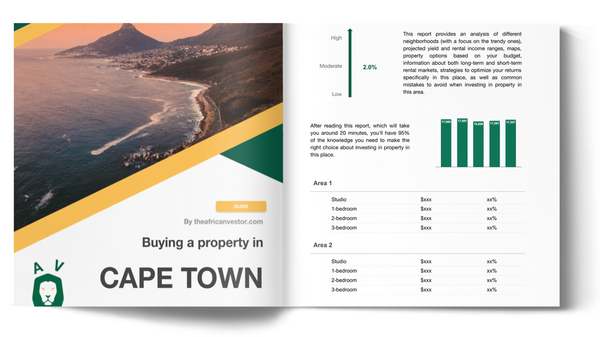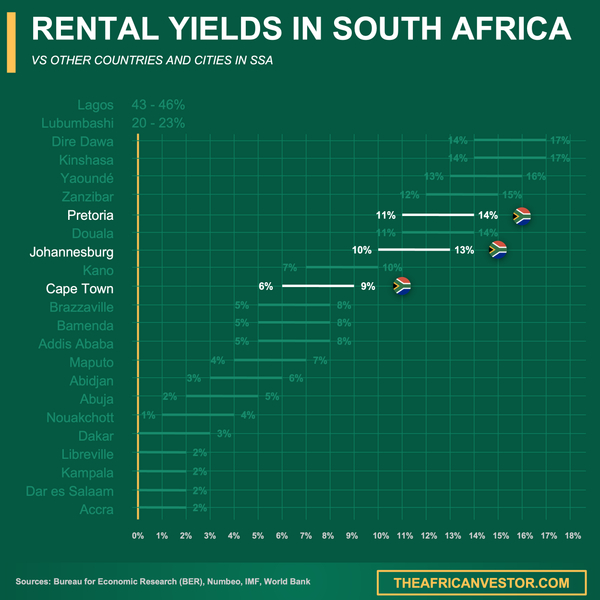Authored by the expert who managed and guided the team behind the South Africa Property Pack

Yes, the analysis of Cape Town's property market is included in our pack
Cape Town's property market offers diverse investment opportunities across neighborhoods ranging from luxury coastal areas to emerging inland communities.
Each neighborhood presents distinct advantages for property investors, with factors like proximity to business districts, infrastructure quality, and demographic profiles significantly impacting both purchase prices and rental yields. Understanding these local market dynamics helps investors make informed decisions about where to buy property in Cape Town.
If you want to go deeper, you can check our pack of documents related to the real estate market in South Africa, based on reliable facts and data, not opinions or rumors.
Cape Town's property prices vary dramatically from R15 million+ in Clifton to R800,000 in emerging areas like Khayelitsha.
Atlantic Seaboard neighborhoods command the highest prices but also offer premium rental income potential for investors.
| Neighborhood | Avg. Home Price (ZAR) | Monthly Rent (ZAR) | Crime Rate per 1,000 | Commute to CBD (min) | Property Growth (5yr) |
|---|---|---|---|---|---|
| Clifton | R15,500,000 | R85,000 | 8.2 | 15 | +32% |
| Camps Bay | R12,800,000 | R75,000 | 9.1 | 18 | +28% |
| Green Point | R6,200,000 | R38,000 | 12.4 | 8 | +25% |
| Constantia | R8,900,000 | R45,000 | 7.8 | 25 | +22% |
| Woodstock | R2,800,000 | R18,000 | 28.5 | 12 | +45% |
| Observatory | R2,100,000 | R15,000 | 24.7 | 15 | +38% |
| Bellville | R1,650,000 | R12,500 | 35.2 | 30 | +18% |
| Mitchell's Plain | R950,000 | R8,500 | 68.4 | 45 | +12% |

How much does it cost to buy a home on average in each neighborhood?
Cape Town's residential property prices vary dramatically depending on location, with Atlantic Seaboard areas commanding premium prices.
Clifton leads the market with average home prices reaching R15.5 million as of September 2025, followed closely by Camps Bay at R12.8 million. These coastal neighborhoods attract international buyers and luxury investors seeking prime real estate.
Mid-tier neighborhoods like Green Point average R6.2 million, while Constantia wine estates typically sell for R8.9 million. These areas offer excellent value for buyers seeking prestigious addresses without Atlantic Seaboard premiums.
Emerging areas present affordable entry points, with Woodstock averaging R2.8 million and Observatory at R2.1 million. These neighborhoods appeal to first-time buyers and investors targeting rental income opportunities.
Suburban areas like Bellville average R1.65 million, while townships such as Mitchell's Plain offer homes from R950,000, making them accessible for local buyers and investors seeking high rental yields.
How much is the average monthly rent for an apartment or house?
Rental rates in Cape Town correlate directly with property purchase prices and neighborhood desirability.
Premium coastal areas command the highest rents, with Clifton apartments averaging R85,000 monthly and Camps Bay properties fetching R75,000 per month. These rates reflect strong demand from international tenants and corporate executives.
Central areas like Green Point offer mid-range rental options at R38,000 monthly, while Constantia properties average R45,000 per month. These neighborhoods provide excellent rental yields for property investors.
Developing areas present attractive rental income opportunities, with Woodstock averaging R18,000 monthly and Observatory at R15,000 per month. These neighborhoods attract young professionals and students seeking affordable accommodation.
Suburban locations like Bellville average R12,500 monthly rent, while areas like Mitchell's Plain offer rental opportunities from R8,500 per month, appealing to local tenants and families.
What is the crime rate per 1,000 residents in each area?
Crime rates across Cape Town neighborhoods vary significantly, with affluent areas generally experiencing lower incident rates.
| Neighborhood | Crime Rate per 1,000 | Safety Rating | Common Incidents |
|---|---|---|---|
| Clifton | 8.2 | Excellent | Petty theft, break-ins |
| Camps Bay | 9.1 | Excellent | Vehicle crime, burglary |
| Green Point | 12.4 | Good | Street crime, theft |
| Constantia | 7.8 | Excellent | Property crime, trespassing |
| Woodstock | 28.5 | Moderate | Robbery, drug-related crime |
| Observatory | 24.7 | Moderate | Mugging, vehicle theft |
| Bellville | 35.2 | Fair | Gang violence, theft |
| Mitchell's Plain | 68.4 | Poor | Gang violence, drugs, murder |
How far is the average commute time to the city center or main job hubs?
Commute times from Cape Town neighborhoods depend on proximity to business districts and transport infrastructure quality.
Central locations like Green Point offer the shortest commutes at 8 minutes to the CBD, while Clifton residents average 15 minutes to reach the city center. These areas provide excellent access for working professionals.
Atlantic Seaboard neighborhoods like Camps Bay require 18 minutes average commute time, while wine estate areas like Constantia typically take 25 minutes to reach business districts.
Emerging neighborhoods offer moderate commute times, with Woodstock averaging 12 minutes and Observatory requiring 15 minutes to reach the CBD. These areas balance affordability with accessibility.
Suburban areas require longer commutes, with Bellville residents averaging 30 minutes and Mitchell's Plain requiring 45 minutes to reach central business areas, though these neighborhoods offer more affordable housing options.
Don't lose money on your property in Cape Town
100% of people who have lost money there have spent less than 1 hour researching the market. We have reviewed everything there is to know. Grab our guide now.

What is the average household income in each neighborhood?
Household income levels across Cape Town neighborhoods reflect the city's economic diversity and historical development patterns.
Atlantic Seaboard areas lead income statistics, with Clifton households averaging R2.8 million annually and Camps Bay residents earning R2.4 million per year. These neighborhoods attract high-net-worth individuals and international executives.
Established suburbs show strong earning potential, with Constantia households averaging R1.9 million annually and Green Point residents earning R1.2 million per year. These areas house successful professionals and business owners.
Developing neighborhoods show moderate income levels, with Woodstock households averaging R450,000 annually and Observatory residents earning R380,000 per year. These areas attract young professionals and creative industries workers.
Working-class areas reflect lower income levels, with Bellville households averaging R280,000 annually and Mitchell's Plain residents earning R165,000 per year, highlighting Cape Town's economic inequality challenges.
How many schools are in the area, and what are their average ratings?
Educational facilities vary significantly across Cape Town neighborhoods, with affluent areas typically offering superior school options.
| Neighborhood | Number of Schools | Average Rating (1-10) | Notable Schools |
|---|---|---|---|
| Clifton | 3 | 9.2 | Sea Point Primary, private tutoring |
| Camps Bay | 2 | 9.0 | Camps Bay Primary, Glen High |
| Green Point | 4 | 8.5 | Green Point Primary, Sea Point High |
| Constantia | 8 | 9.3 | Reddam House, Rustenburg Girls |
| Woodstock | 6 | 6.8 | Woodstock Primary, Salt River High |
| Observatory | 5 | 7.1 | Observatory Primary, Groote Schuur |
| Bellville | 12 | 6.5 | Bellville High, Parow Primary |
| Mitchell's Plain | 18 | 5.2 | Spine Road High, Rocklands Primary |
What percentage of properties are owned versus rented?
Property ownership patterns across Cape Town neighborhoods reflect income levels and housing market dynamics.
Affluent coastal areas show high ownership rates, with Clifton at 78% ownership and Camps Bay at 74% ownership. These neighborhoods attract buyers seeking long-term investments and luxury lifestyle properties.
Established suburbs maintain strong ownership levels, with Constantia at 82% ownership and Green Point at 65% ownership. These areas appeal to families and professionals seeking stable residential communities.
Emerging neighborhoods show mixed patterns, with Woodstock at 45% ownership and Observatory at 48% ownership. These areas attract both investors and young professionals entering the property market.
It's something we develop in our South Africa property pack.
Working-class areas show lower ownership rates, with Bellville at 62% ownership and Mitchell's Plain at 38% ownership, reflecting economic constraints and historical housing policies.
How much have property values increased or decreased over the past five years?
Cape Town property market performance varies significantly by neighborhood, with emerging areas often outperforming established locations.
Woodstock leads property growth with 45% increases over five years, followed by Observatory at 38% growth. These neighborhoods benefit from urban renewal and proximity to business districts.
Atlantic Seaboard areas show solid appreciation, with Clifton properties gaining 32% and Camps Bay increasing 28% over five years. These premium locations maintain steady demand despite high entry prices.
Central areas demonstrate consistent growth, with Green Point properties appreciating 25% and Constantia gaining 22% over the five-year period. These neighborhoods offer balanced investment potential.
Suburban areas show moderate growth, with Bellville gaining 18% and Mitchell's Plain increasing 12% over five years, reflecting local economic conditions and infrastructure development.

We did some research and made this infographic to help you quickly compare rental yields of the major cities in South Africa versus those in neighboring countries. It provides a clear view of how this country positions itself as a real estate investment destination, which might interest you if you're planning to invest there.
What is the population density per square kilometer?
Population density across Cape Town neighborhoods reflects urban planning patterns and housing development history.
Central areas maintain high density levels, with Green Point at 8,500 residents per km² and Observatory at 7,200 residents per km². These neighborhoods offer urban lifestyle benefits with access to amenities and transport.
Coastal areas show moderate density, with Clifton at 2,800 residents per km² and Camps Bay at 1,900 residents per km². These exclusive neighborhoods maintain low-density character through zoning regulations.
Wine estate areas like Constantia maintain low density at 1,200 residents per km², preserving suburban character and large property sizes that appeal to families seeking space and privacy.
Emerging neighborhoods show varied density, with Woodstock at 6,800 residents per km², reflecting ongoing urban development and apartment construction projects.
Township areas show high density levels, with Mitchell's Plain at 12,400 residents per km² and Bellville at 5,600 residents per km², reflecting historical housing policies and current urbanization pressures.
How many public transport options are available on average per neighborhood?
Public transport accessibility varies significantly across Cape Town neighborhoods, impacting property values and resident mobility.
Central areas offer the most transport options, with Green Point providing 8 different routes including MyCiTi buses, minibus taxis, and Uber services. Observatory offers 6 transport options with railway access to the city center.
Atlantic Seaboard areas provide moderate options, with Clifton offering 4 transport routes mainly consisting of MyCiTi buses and private shuttles. Camps Bay provides 3 transport options, primarily tourist-focused services.
Suburban areas show limited options, with Constantia offering 3 transport routes and Bellville providing 5 options including train connections. These areas rely heavily on private vehicle ownership.
Emerging neighborhoods like Woodstock offer 5 transport options including rail connections, while township areas like Mitchell's Plain provide 7 routes, mainly minibus taxi services connecting residents to job centers.
What is the average age of residents in each area?
Age demographics across Cape Town neighborhoods reflect economic factors, lifestyle preferences, and housing market dynamics.
1. **Clifton and Camps Bay (Average age: 45-50 years)** - These areas attract established professionals and retirees with substantial wealth seeking luxury coastal living. 2. **Green Point (Average age: 35 years)** - Young professionals and couples prefer this central location for its proximity to business districts and nightlife. 3. **Constantia (Average age: 48 years)** - Families with children and established professionals choose this area for its schools and suburban lifestyle. 4. **Observatory (Average age: 28 years)** - Students and young professionals are drawn to this bohemian neighborhood near the university. 5. **Woodstock (Average age: 32 years)** - Creative professionals and young families attracted to urban renewal and arts scene. 6. **Bellville (Average age: 38 years)** - Middle-class families seeking affordable suburban living with reasonable commute access. 7. **Mitchell's Plain (Average age: 29 years)** - Young families and working-class residents, reflecting historical settlement patterns and economic opportunities.How many hospitals, clinics, or healthcare centers are located within a 5 km radius?
Healthcare facility access varies across Cape Town neighborhoods, with central areas offering superior medical services.
Central and affluent areas provide excellent healthcare access, with Green Point offering 12 medical facilities within 5km including private clinics and Groote Schuur Hospital. Clifton and Camps Bay provide access to 8 facilities, mainly private practices and specialist clinics.
Constantia residents access 10 healthcare facilities including Constantiaberg Hospital and numerous private practices, making it attractive for families and older residents.
Emerging neighborhoods show moderate healthcare access, with Observatory offering 7 facilities including university medical services and Woodstock providing 6 healthcare options within the radius.
It's something we develop in our South Africa property pack.
Suburban and township areas face healthcare challenges, with Bellville offering 5 facilities and Mitchell's Plain providing 4 healthcare centers, often requiring residents to travel further for specialized care.
Conclusion
This article is for informational purposes only and should not be considered financial advice. Readers are advised to consult with a qualified professional before making any investment decisions. We do not assume any liability for actions taken based on the information provided.
Cape Town's property market offers diverse investment opportunities across neighborhoods with dramatically different price points and growth potential.
Atlantic Seaboard areas command premium prices but offer prestige and rental income, while emerging neighborhoods like Woodstock and Observatory provide strong capital growth prospects for investors willing to accept higher crime rates and longer development timelines.
It's something we develop in our South Africa property pack.
